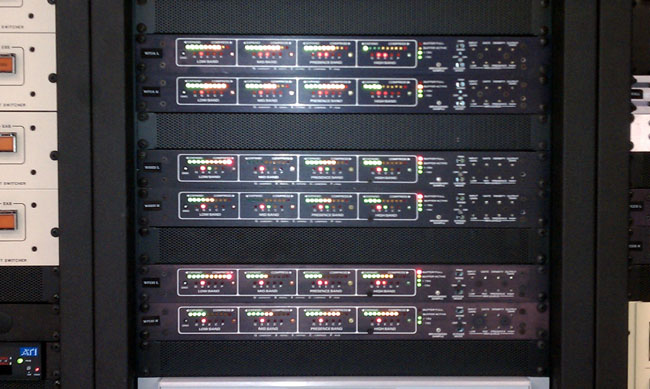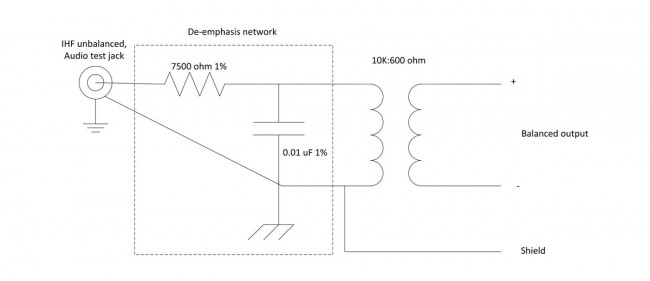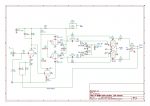I give to you, the original Texar Audio Prism:

I love the sound of these units when coupled with an Optimod 8100A. Many people have (or rather, had) difficulty setting these things up. I found them to be very easy to deal with, just follow the instruction manual. If that doesn’t sound good, then there is something wrong with the unit. Over the years, there are only a few consistent problems. The first thing is with the voltage regulators. They have heat sinks attached with nylon screws. The screws get brittle and fall apart, making the regulator overheat and go bad. I have taken to replacing the nylon screws, and if the heat sink has fallen off, the entire regulator. There are also a few electrolytic capacitors in the power supply and on the audio board, it is always a good practice to replace those. Otherwise, unless the unit has been blown up by lightning, it should work.
As for set up, follow the directions in the manual:
- Bypass the units using the bypass switch
- Turn on the onboard pink noise generator
- Using the test ports on the front of the unit, plug a Simpson 260 VOM set on 2.5 VAC important: use the ground port on the front of the unit, not the case
- For use with an Optimod 8100A, using the dB scale on the Simpson 260, set all the bands for a 4.0 reading. Set the density to 3/4.
- Turn off the pink noise generator and switch out of bypass mode.
- Make sure the levels in the studio are where they should be.
- Adjust the input gain so the “Buffer Active” light does not come on during normal-level programming.
- Adjust the output levels so that the input buffer on the Optimod reads between -7 and -3 vu.
The rest of the settings are on the Optimod:
- Clipping = 0
- HF limiting = 5
- Release time = 2
- Bass coupling = 2
- Gate = 0
- Set the input attenuators for about 10 dB total gain reduction, with peaks around 15 dB or so.
Then set the L-R null. To do this, make sure the program material is in mono, then adjust the L or R input attenuator for minimum reading. Also, if the Audio Prism has PR-1 (phase rotators) installed, bypass the phase rotator in the Optimod. There is also a replacement card 5 made by Gentner called the RFC-1 for the Optimod 8100A. I notice little difference between a stock Optimod and an RFC-1 Optimod.
That is a good starting point. Most people are quite happy with this, but if needed, the high and low settings on the Prism can be adjusted slightly to suit the station equipment. When properly adjusted, this equipment rides gain, and adds a certain amount of loudness, while keeping the programming material natural sounding. Further, unlike some “modern” air chain processors, it does not boot up and it does not occasionally lose its mind, requiring a reboot.
The best paragraph in the manual, or any broadcast equipment manual is this:
There is a wealth of information available in the LED display. A few minutes of watching them in reduced light (emphasis added) while listening to a familiar program input will greatly help in understanding their action.
It will also greatly enhance your buzz, dude. It was the 70’s.






These were GREAT units until Gentner bought Texar and screwed up the design.
I was a principal in company from 1981 to 1986. The Texar magic was in the filter design that was phase linear although at the sacrifice of peak control. The ripple equated to 3 db which was easily handled by the Optimod or the onboard AM limiter that followed, but alarming to some. The CMOS logic with the variable density window made significantly less gain changes that lessen listener fatigue. The design also flatten the charging curve on the timing capacitors so the action was the same regardless of where the unit was driven. The first generation had meters of which about 16 were made. The second generation had a “dot” LED display. The third generation had fullwave peak detection and lower noise and the LED bar design. The current drain is what created the power supply problems. The RFC-1 (Replacement Five Card) was defensive move as Orban redesigned the stock Card 5 with the release of the XT with time constants so slow that the Texars were no longer competitive.
Jim, thanks for stopping by. I know of at least 8 stations that we do work for which still use some form of the audio prism and they are still competitive. Interesting note on the RFC-1, I will have to look and see what vintage 8100’s we are driving. I do have a few of the RFC-1 cards on the shelf… somewhere…
Do you have a hard-copy version of the manual for these? The one with the photo of the Texar on the front with rainbow colours emanating from the LEDS…
There is a side insert on the binder as well. What I am looking for is one of these binders – I can print my own manual from PDF if needed, but if the binder was a complete manual I’d be even more excited!
Otherwise, some good quality scans of the front and side inserts of the binder would be greatly appreciated.
Cheers.
I have 2 Pair or Audio Prisms Driving 2 Optimod 8100’s I Also have to 8500’s What would come if I drove the 8500’s with another pair Or Texar’s. ALSO does any one know where I can get the Eagle Audio Clipper for them.. Also Has Any one used them In am Am Stereo Operation CQUAM?
J.D Ford
Engineer
KWHW Radio
These are great directions for prism setup. Thanks for the engineer sharing.
No problem, Steve.
Looking for a service vendor to refurbish a pair of texar audio Prisms. Do you have a source that you would reccommend/
Thanks.
mark
I recently inheirited the maintenance of an FM station. There were NO manuals to anything when I arrived. I have just about competed getting manuals for most of the equipment. On area of concern is an Orban 5100-A. The inner panel behind the front locked door indicates a Gentner RFC-1 card installed. I would assume this was a factory install job. I can find NO info anywhere on this particular Orban. This Orban was installed, so I am told, a year ago. Whoever installed it went off and left the 19 Khz pilot disabled and heavens knows what else was overlooked. Does anyone know where I can get manuals on this particular Orban? I am hesitant to tackle this unit without some decent manuals at my side. If allowed, my e-mail is kylo@comcast.net. Any help would be appreciated.
Sorry for the error. The unit is an Orban-FM 8100-A with a Gentner RFC-1 card, NOT a 5100-A
Mike, I found this link for the manuals:
ftp://ftp.orban.com/8100A1/
Paul, thank you so much for the link. The info contained will go a long way in my trying to straighten out the mess I found. Your help is much appreciated.
Have a couple of Texar Prism for sale…used very little in boxes with manual. Any interest???
Ron Bishop
662 667 3969
I had done some major rebuilds on Texar prisms and the two most difficult things were finding the proper replacement Vactrols and acquiring the alignment procedure for the M101 cards.
Besides replacing all the electrolytics I replaced the Vactrols as well as replacing the bias pots on the M101 cards with 10 turn ones. Once they are aligned they work quite well. Replacing the regulators and securing the heat sinks are great suggestions regardless of if you’re going to do a major refurb.
The only other thing I did, for both cosmetic purposes and for ease in reading the indicators, I replaced the compress and expand status LEDs on each band with LEDs matching the corresponding metering – probably not necessary, but I noticed this was done on the later production units.
running this on an AM to create a more FM-like sound.
I’m running a Compellor 320 into a pair of Texars into an 8200 with the AGC turned off. It sounds very clean and detailed, with a lot of low-end thump. Much better than an Optimod 8300 on the same station. Maybe not quite as loud but very nice!
Think someone should manufacture new control covers to replace all the misplaced ones. Like mine.
the station I work for has 2 of these , sounded muddy and flat , did the adjustments you suggested . sounds GREAT now !! Lows alittle mids and Plenty of high`s … thanks !!
my ears thank you!
Richard, if you have the know how, I would recommend doing the following maintenance items;
The power supply regulators are attached to heat sinks with nylon screws and nuts. Over the years, these deteriorate due to heat. Replace the nylon screws and nuts in kind, I believe there are three of them.
While you are at it, replace the electrolytic capacitors in the power supply.
Do those things and the Texars should last another thirty years!
Hello to all
I am looking for a complete manual Audio Prism with electronic drawing (M101&M102 cards) and procedure for change and adjust the vactrols, etc
Somebody can help me?
I wish receipt with pleasure this documentation on this e-mail: telecom.cat@hotmail.com
Thank for your Help
Francisco
hey there Paul, thanks for the advice on the Texar prisms. Replacing the nylon screws and nuts and power supply caps are on my list of things to do after a 3 transmitter install. I have one other question, I must have first gen units. I don’t have the ground point on the faceplate. during the first round of set up I used the case as ground and it really made the station sound much better. a lot better. I was conservative in the voltage readings and was trying to get the units balanced in the channels between the right and left channels . so , without the Ground test points , will using the case be ok to use? as I said they sound wonderful . but you know how us engineers are . lol
My grandpa was the vice president of Texar his name is Barry or Barack Honel.
Mr.Thurst , i am having some issues with a Texar Prism and was wondering if i can ask you a question or 2, thanks.
Mr. Thurst… I’d like to pick your brain regarding the digital Optimods. Could you email me.
I just bought two Texar Audio Prisms and one Gentner for restoration. I remember these from Q102 in Dallas and my intent is to use them for audio mastering.
I have M-101 and MB-2 documents and will be posting a circuit analysis soon on the proaudiodesignforum.com
One maintenance suggestion I have to add to those previously posted – and one familiar to MCI tape machine owners – is to re-solder each and every one of the male Molex pins (the white ones) where they solder to the motherboard. These connectors, whose pins are round, develop microscopic ring cracks making intermittent connection. After all these years I found all three exhibited intermittents. In only takes a few minutes to pop the motherboard out and redo them.
I also have a pair of potted phase rotator modules that I will not be needing.
I now have the M-101 schematic posted and will be adding more information.
“Texar Audio Prism Schematics and Information” http://www.proaudiodesignforum.com/forum/php/viewtopic.php?f=12&t=763
Any chance you can help me find an Optimod XT2 for the 8100A?
Thanks.
Todd, I don’t know of any laying around anywhere, but I’ll keep my eyes open
Does anyone have a RFC1 faceplace for an optimod?
Hello friends, I am Brazilian, I am buying a pair of audio prism to use in conjunction with an Orbam 8100. I would have a second option would be to buy “Stereo Tools” or a third option would be to use “Breakawayone”. What is the best quality choice for FM broadcasters?
NAVAL – Brazil, Don’t stick out with Stereo Tool, You won’t like the sound of it. If you’re accoustumated with “Analog Sound” then buy BreakawayOne, They’re top-end processors for these days, The Optimod 8100 is not recommended if you don’t use some high quality stereo generator (BaOne can be used!!) on my opinion. It can’t even go up for -5db on De-Emphasis. I’ve set up some stations with Optimod 8100 and BreakawayOne as their stereo generator, The MPX Clipping and builtin RDS works perfect with the L/R Output of Optimod 8100. The sound is exactly the same but WAY LOUDER and cleaner.
Hey guys
I have a Texar Audio Prism with the AMC-2 Rev. 2 peak limiter board installed.
Anyone here have any information, setup, or schematics for this.
Thanks. Email racalra17@gmail.com
Al
Hello all
Is this forum still active?
I am from Peru, living in Arizona,
I just got a question about an radio station very nice sound by using the 8100A with the XT2 any help?
Thanks
Felix
Still for sale?
Any one got prisms for sale?
Please contact
Jim, did you work with my dad then?
Barry who was VP?